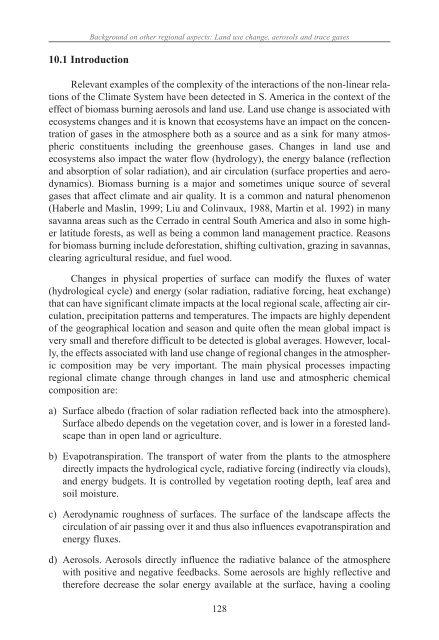chapter - Atmospheric and Oceanic Science
chapter - Atmospheric and Oceanic Science
chapter - Atmospheric and Oceanic Science
You also want an ePaper? Increase the reach of your titles
YUMPU automatically turns print PDFs into web optimized ePapers that Google loves.
Background on other regional aspects: L<strong>and</strong> use change, aerosols <strong>and</strong> trace gases<br />
10.1 Introduction<br />
Relevant examples of the complexity of the interactions of the non-linear relations<br />
of the Climate System have been detected in S. America in the context of the<br />
effect of biomass burning aerosols <strong>and</strong> l<strong>and</strong> use. L<strong>and</strong> use change is associated with<br />
ecosystems changes <strong>and</strong> it is known that ecosystems have an impact on the concentration<br />
of gases in the atmosphere both as a source <strong>and</strong> as a sink for many atmospheric<br />
constituents including the greenhouse gases. Changes in l<strong>and</strong> use <strong>and</strong><br />
ecosystems also impact the water flow (hydrology), the energy balance (reflection<br />
<strong>and</strong> absorption of solar radiation), <strong>and</strong> air circulation (surface properties <strong>and</strong> aerodynamics).<br />
Biomass burning is a major <strong>and</strong> sometimes unique source of several<br />
gases that affect climate <strong>and</strong> air quality. It is a common <strong>and</strong> natural phenomenon<br />
(Haberle <strong>and</strong> Maslin, 1999; Liu <strong>and</strong> Colinvaux, 1988, Martin et al. 1992) in many<br />
savanna areas such as the Cerrado in central South America <strong>and</strong> also in some higher<br />
latitude forests, as well as being a common l<strong>and</strong> management practice. Reasons<br />
for biomass burning include deforestation, shifting cultivation, grazing in savannas,<br />
clearing agricultural residue, <strong>and</strong> fuel wood.<br />
Changes in physical properties of surface can modify the fluxes of water<br />
(hydrological cycle) <strong>and</strong> energy (solar radiation, radiative forcing, heat exchange)<br />
that can have significant climate impacts at the local regional scale, affecting air circulation,<br />
precipitation patterns <strong>and</strong> temperatures. The impacts are highly dependent<br />
of the geographical location <strong>and</strong> season <strong>and</strong> quite often the mean global impact is<br />
very small <strong>and</strong> therefore difficult to be detected is global averages. However, locally,<br />
the effects associated with l<strong>and</strong> use change of regional changes in the atmospheric<br />
composition may be very important. The main physical processes impacting<br />
regional climate change through changes in l<strong>and</strong> use <strong>and</strong> atmospheric chemical<br />
composition are:<br />
a) Surface albedo (fraction of solar radiation reflected back into the atmosphere).<br />
Surface albedo depends on the vegetation cover, <strong>and</strong> is lower in a forested l<strong>and</strong>scape<br />
than in open l<strong>and</strong> or agriculture.<br />
b) Evapotranspiration. The transport of water from the plants to the atmosphere<br />
directly impacts the hydrological cycle, radiative forcing (indirectly via clouds),<br />
<strong>and</strong> energy budgets. It is controlled by vegetation rooting depth, leaf area <strong>and</strong><br />
soil moisture.<br />
c) Aerodynamic roughness of surfaces. The surface of the l<strong>and</strong>scape affects the<br />
circulation of air passing over it <strong>and</strong> thus also influences evapotranspiration <strong>and</strong><br />
energy fluxes.<br />
d) Aerosols. Aerosols directly influence the radiative balance of the atmosphere<br />
with positive <strong>and</strong> negative feedbacks. Some aerosols are highly reflective <strong>and</strong><br />
therefore decrease the solar energy available at the surface, having a cooling<br />
128






